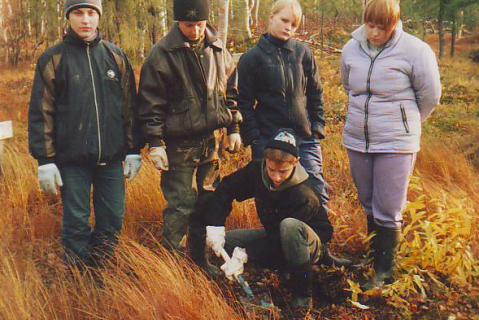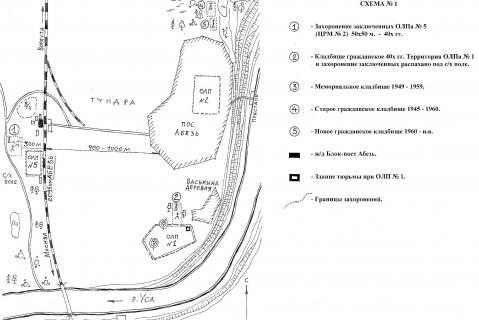In the 1940s camp outpost No 5 of Sevpechzheldorlag and the central repair workshops were located in Abez, the headquarters of the camp system. The camp’s cemetery was discovered in the early 1990s by local historian V.V. Lozhkin who tidied the area and placed stakes bearing number plates on the graves as a stylised representation of the original camp markers. The burials are thought to date to the mid-1940s. The numbers buried there have not been established.
In September 2005, the cemetery was studied by an expedition of the Inta museum of history and local studies together with pupils from secondary school No 6 (expedition director, N.A. Baranov).
(According to the key the attached plan shows: [1] burials of prisoners from outpost 5; [2] 1940s civilian graveyard, The territory of camp outpost 1 and the prisoners burial ground were ploughed up for agricultural purposes”; [3] the memorial graveyard; [4] the old civilian graveyard, 1945-1960; [5] the new civilian graveyard, 1960 onwards; the railroad checkpoint; and the prison in camp outpost 1.)
| State of burials | Area | Boundaries |
|---|---|---|
|
Subsidence indicating location of burials: a //bricklayer’s gauge can be traced. Two grave-markers have survived
|
About 2,500 sq m
|
Not delineated
|
[ Original texts & hyperlinks ]
A report on the Inta local history museum’s expedition to uncover mass burials of the victims of political repression (Abez 2005) – Archive of the Pokayanie Foundation (Syktyvkar)
I. Shcherbakova (compiler), “’We paid with our lives’, The cemeteries of the Abez camp prisoners”, Stengazeta, 16 November 2006 [retrieved, 27 May 2022]
N.A. Baranov, “Abez as part of the Gulag”, Iskra, tvoya gorodskaya gazeta, 16 April 2012
Reply from the Inta urban district administration (№ 09/8359 of 25 June 2014) to a formal enquiry by RIC Memorial (St Petersburg)


